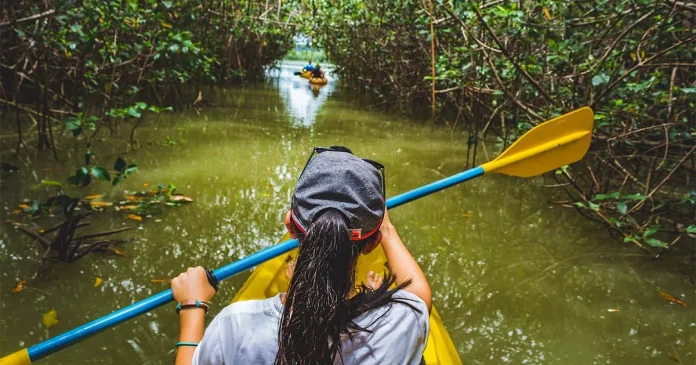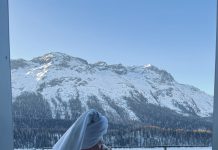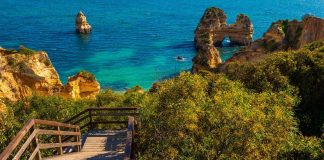The best things to do and places to go for ecotourism, either on a budget or with a bit of luxury. We’ve got popular eco-friendly destinations and undiscovered gems for everyone
Kiwi.com provides customers with the best deals on cheap flights all year round, so here are our picks for ecotourism destinations across the world. Let’s explore!
Central and South America
This region is pretty much where the whole concept of ecotourism began (or at least where it became known as such), with tourist boards finding a new angle with which to attract visitors to places that hadn’t necessarily been destinations before. So we begin in Panama, a beautiful and ecologically diverse country and home to Coiba Island National Park. The largest island in the region, it became separated from the mainland around 15,000 years ago, and in that time plant and animal life diversified from that of anywhere else. It was also untouched for a bleaker reason: between 1919 and 2004 the island was used as a prison, with no-one visiting at all. Isla Coiba became a Unesco-protected site in 2005, and Panama is, naturally, proud of this utterly unique place, so you can understand their wish to protect what’s become known as ‘the new Galápagos’. If you’d like to visit, you’ll need a permit from the National Authority for the Environment, but there are tour operators who can arrange this.
Something wild in a different sense now, as we head to Costa Rica for a spot of white water adventure. From San Jose, you can hire guides and rafting equipment for a wild ride down the Pacuare River: raging rapids hurl you between canyon walls and booming waterfalls, deeper and deeper into the rainforest, before finally, you’ll reach the Pacuare eco-lodge. It’s a stunning location, and this seemingly simple but deceptively luxurious lodge offers delicious, locally-sourced food, and gorgeous views of the rainforest and distant mountains from your pool, balcony or bed. When you’re sufficiently relaxed, hike into the hills to meet the Cabécar people and learn about their culture and traditions, or explore the rainforest canopy on a two-hour tour, rappelling and ziplining your way between wooden platforms high in the trees.
Finally for this section, we’re off to Peru. You might think we’d go obvious and select hiking to Machu Picchu, but while that is a classic Peruvian experience, Peru is trying to negate the effects of mass tourism there. We’re going for the Sacred Valley instead. It’s an incredible location, not only to learn about the traditions of the Incan Empire, it’s also one of the country’s agricultural centers, supplying Cusco and the nearby region with delicious produce. Tourism authorities are now supporting those local communities by encouraging visitors to engage in tours with local guides and learn about the crafts, art, language and history of the Sacred Valley region.
Africa
A country that takes its ecology and nature incredibly seriously is Namibia. It has one of the oldest conservation programs in the world, and an entire branch of government set up specifically to protect its wildlife. It has strict rules regarding safaris, encourages interaction and learning the traditions and history of local villages, and helps to set up social enterprises to benefit people both locally and nationally. Most of the national parks in Namibia contain eco-lodges, all constructed using local materials and employing local people. If you’re taking your first steps into the world of ecotourism and what it can offer, Namibia might just be the destination for you.
The Okavango Delta National Park in Botswana is a fine choice for those who want a bit of luxury, and, equally, for those who want to experience nature as closely as possible. How so? Well, along with the luxury eco-lodges dotted around the region, you can also choose to simply take a tent and camp out under the stars. The eco-resorts consist of lodges in which you can live in luxury while not feeling guilty about it: the Botswana Ecotourism Certification System means you can trust that everything is local and sustainable, from the food to the energy supply. As for things to do, you can hike the beautiful teak forests, take an overnight trip into the wilderness with a guide, or paddle a mokoro (a traditional canoe) to meet the varied wildlife such as hippos, lions and buffalo that live in and around the sparkling lagoons.
Our last African destination is Mozambique where the Banhine National Park is working to help locals see ecotourism as an opportunity to earn money for themselves and their communities. The park is a haven for hundreds of species of birds, both on its vast grassy plains and in the wetland areas, so conservation and anti-hunting laws are extremely strict, but the region is also a center for illegal charcoal production which destroys their natural habitat, thus damaging wildlife indirectly. Schemes are now being put in place which aim to foster better relations between the guardians of the park and local residents, encouraging them to see ecotourism as a viable and sustainable way of making money.
Australia
So, you like sand, eh? Fraser Island, to the north of Brisbane, is the largest sand island in the world at 123 km in length, and also the only place on the planet where rainforests grow on sand dunes. You can explore the island on a day trip, or spend up to five days making sure you don’t miss a thing, from whale watching, to spotting the rare and unusual animals and plants that make up this unique ecosystem: it’s not unusual to see a pack of dingos loping along the beach, or an ancient lizard lounging in the trees. In the dips between the sand dunes and in the forest, there are dazzling freshwater lakes for swimming, and in the evenings you can set up your tent in one of the designated campsites and listen to the chatter and rustle of nature all around you.
Covering over 12,000 square kilometers of the Northern Territory, Kakadu National Park has been home to Aboriginal people for between 20,000 — 40,000 years, and is rich in indigenous culture, including around 5,000 recorded art sites, ancient rock paintings preserved and giving a glimpse into Aboriginal life and history. There are four rivers (including the self-explanatory Alligator River), as well as estuaries, floodplains, lowlands, hills and basins, and hiking, boating and birdwatching are all popular activities. Today, the land is being given back to its rightful owners under the Aboriginal Land Rights Act of 1976, with around 500 Aboriginal people living in the park.
Europe
It’s not necessarily the continent you’d think of when it comes to ecotourism, but there are corners where the bustle of everyday life can be forgotten. One of those places is the Western Isles of Scotland, and the Hebrides count renewable energy production as one of their primary industries. Discover the islands by bicycle, rent a sea kayak and paddle your way around, hike the gloriously lonely hills, or treat yourself to a tour of some of the traditional whisky distilleries on the likes of the isles of Jura, Islay, Uist and other romantically windswept places.
In the very north of Finland, the Wild Taiga region is an amazing place to see incredible wildlife, including some of the only brown bears in Europe. Between April and September, the area teems with life; not only bears, but wolves, moose, reindeer, foxes, beavers and more. In order to show the public these animals but also to allow them to thrive undisturbed, around 60 companies are now part of the Wild Taiga travel trade association. This means that all accommodation and transport used during the trips are locally owned and tour leaders are trained in responsible and sustainable tourism, meaning you can see this spectacular terrain and its inhabitants while knowing that you’re not impacting their habitat or happiness.
Did you like this article? For more travel inspiration, visit Kiwi.com Stories.






















